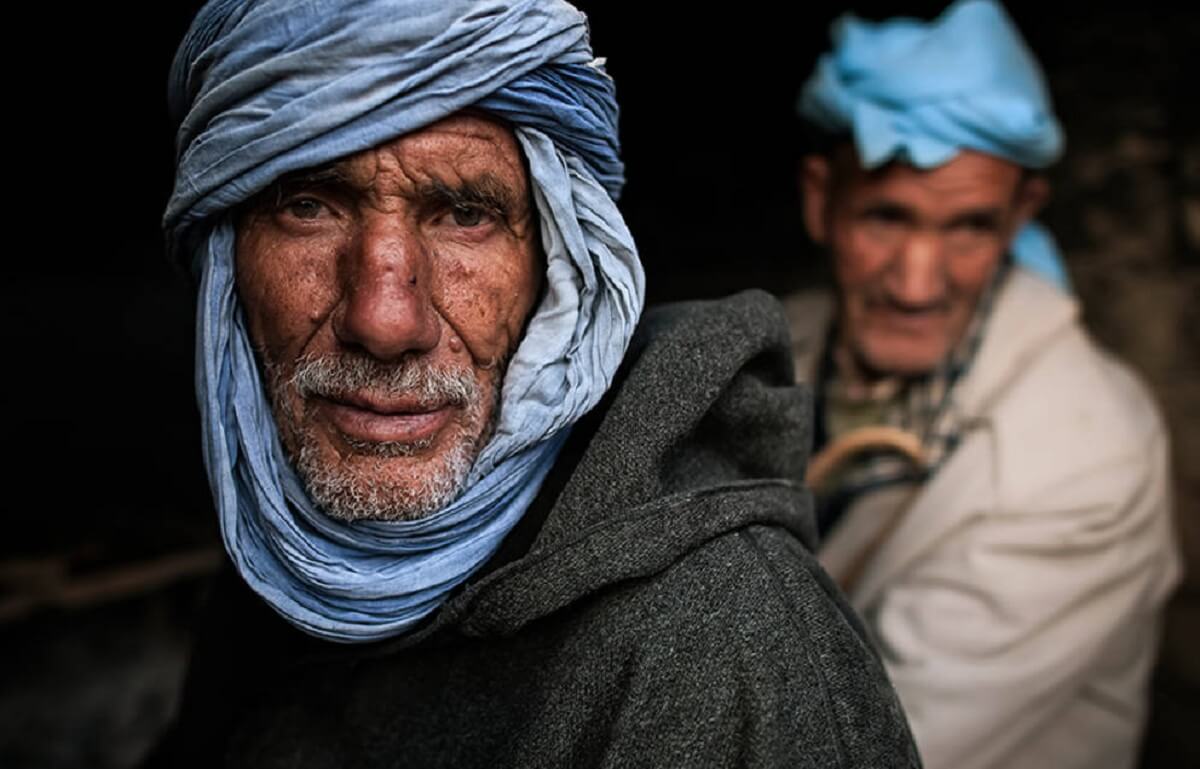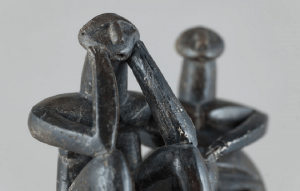The dust of time…
In North and Northwestern Africa, on the west side of the Nile River, live the “Berbers”, as the Arabs call them, or Kabyle, Imazighen (singular: Amazigh), Imazyen or Tamazight, as they call themselves; they number approximately 23 million people, residing in enclaves scattered throughout Libya, Algeria, Morocco, Mauritania, Niger, Mali and Tunisia.
They consider themselves to be the native people on those lands who converted to Islam in the VII century, after having practiced both Judeo-Christianity and the Ariminic Christianity for over 200 years. These people, strongly Islamized and Arabized, present a significant peculiarity: anthropologically speaking, they are connected to the populations inhabiting the Central and Eastern Europe; however, no one made time to study them and wonder why most of the Berbers resemble the populations we previously mentioned and why some of the clothes they wear have elements also encountered in the Romanian folk costumes and in the traditional clothing of the Tohari people living in the Asian part of Russia. Seeing that their history directly concerns us, I will begin rummaging through the dust of time to find the traces of the lost steps and of the calls to remembrance.
The first people on Earth
An Emesh hymn says that Enki, meaning Mother Earth, gave her son Inzak or Imzag dominion over the entire country of Dilmun. The land of Dilmun is the territory situated to the north and south of the Danube, where we can find the oldest traces of civilization and the ancient stronghold of Dimum, dating from the 4th millennium B.C. These populations were the first to use writing. The Emesh (or Sumerians as the lying rascals called them) began their migration from the Carpathian region, a historical truth which can be proved not only by the 2.982 words in the ancient Romanian, similar with the Eme-gi dialect and other 4.405 Romanian words composed of two or more Eme.gi phonemes, but also by the information provided by the lead plates discovered in Sinaia. Perhaps Imzag in the Emesh myth is Pelasgus or Atlas in the mythology of these lands made known through the ancient Greek writings.
A semantic analysis of the word Imazighen or Imazyen reveals a piece of the true history of our people, so terribly oppressed by fate; ima: fertile earth, crowd + zig: to be thrown out, to break off, to uproot oneself, to last, sky, tall, strong + en: land, country, ancestor. Or, in the second case, ima + zyen: deity of the moon and resurrection in the Emesh and Getic mythology, also written as Zuen, Zoen, Zoin – direct reference to the legend of humankind born from Maia, daughter of the Titan Atlas, who lived in the skies together with her six other sisters. The term ,,amazigh” decomposes into ama: mother, ox + zig: to be thrown out, to break off, to uproot oneself, to last, sky, tall, strong, also alluding to a people descended from the gods through the solar bull as a totem of the first people on Earth. The word Imazighen (in Tifinagh writing: Imaziγen) is the plural form of Amaziğ, which according to the medieval scholars Ibn Hazm and Ibn Haldun would mean “father”, “leader” or “freeman”.
We know a Greek version of this myth which says that Uranus, the creator of the world (Ur: origin, soul, heart, being, foundation + Anu: God) gave his son Atlas dominion over the lands situated north of the Danube and meant as eternal halidom for the People Descended from the Gods; from Atlas, this country blessed by the Heavenly Father, came to the Hyperborean or Pelasgian Japheth. The clay plates discovered in the lands where in ancient times lived the Emesh/Sumerians, say that on the island we call today Failaka, situated east of Kuwait, there used to be a temple sacred to Imzag of Dilmun and the merchants paid homage to this deity when they returned with silver from the faraway country of Dilmun, where a round trip took two years.
The ancient Greeks
In the same temple they also paid homage to the goddess Nigal of Ur. To the mythological information transmitted from Antiquity, I will add below a few historical data that nobody truly understood so far. The ancient Greeks left us a story about the legendary king Danaos or Danaus, assumed to have ruled in Argos, Peloponnese, in the beginnings of their civilization. They also tell us that this king was born in Lybia – a country that was once controlled by the famous Gaetuli – and he had a brother called Aegyptos; after the death of their father Belos, who also ruled over the lands from beyond the Nile River, the kingdom was divided between the two sons: Danaus received Lybia and Aegyptos received the land of the Nile, which he named after him. Aegyptos had fifty sons, whereas Danaos had fifty daughters and Aegyptos asked his brother to marry their children, in order to restore the old kingdom of their father. However, Danaos, suspecting that his brother had evil thoughts, put his entire kin and luggage into ships and set sail in secret to Peloponnese, where his uncle had built the stronghold of Argos, and he became king of these places due to the predictions of an oracle. During his reign, king Danaos or Danaus issued a law to change the name of the “Danaans” (meaning those he had brought with him) into Pelasgians, same as his uncle’s people and the ancient people who had built the stronghold. After Danaos’s death, the throne passed again to Gelanor, also called the Pelasgian, the former king. There are other myths which also say that the Danaans were Pelasgians, meaning the same people, but they were related to the ancient Egyptians. We encounter the same information written several times in the Torah, saying that the Philistines were brothers to the ancient Egyptians and that the Egyptians colonized Macedonia, led by the “brave” Macedo, covered in a wolf hide; his name also gave the name of the country. However, in Canaan there was the stronghold of Macedo, also known under the name of Megiddo.
In the work Description of Greece II, 19, the author Pausanias who lived during the 2nd century A.D., writes that after the death of king Danaos, the throne passed to Pelasgos, without mentioning if he was Gelanor or if this was actually the name of the new king. About these legendary facts we also have the testimony of the writer Ctesias who lived in the 5th century B.C. Ctesias tells us that a king of the Scythians (meaning of the Getae, because the Greeks called all those who lived north of the Ister Scythians) defeated the Egyptian pir-o (pharaoh) Sesostris on his own lands, retreating afterwards to his homeland.
In his work Philippic Histories, the Latin writer Trogus Pompeius, who lived in the 1st century B.C., left us a testimony that king Tanausis of the Getae (meaning the Getae who lived north of the Ister) defeated the Egyptian king Vesosis on the banks of the river Phasis (possibly a branch of the Nile River flowing into the Delta). Furthermore, the Greek historian Philo of Byblos, who lived in the 1st century A.D., wrote that the Egyptian pharaoh Sesostris came with a large army north of the Ister to subdue by sword the Getae king Tanausis or Danaus. The author says that he took this information from Sanchuniathon’s Phoenician history, written in the 12th century B.C., which he translated into Greek. Valerius Flaccus, another Latin writer who lived in the 1st century A.D., writes in Argonautica: “Sesostris was the first king to wage war upon the GETÆ, but terrified by the slaughter of his army, he withdrew fast to Thebes, on the banks of the Nile, accompanied by only a few of his people”, meaning that all their bravery had turned into a terrible defeat.
G E T I C A
Jordanes, in Getica, tells us at VI,47: “This was the region where the Goths dwelt when Vesosis, king of the Egyptians, waged war upon them. In a battle at the river Phasis (whence come the birds called pheasants, which are found in abundance at the banquets of the great all over the world) Tanausis, king of the Goths, met Vesosis, king of the Egyptians, and there inflicted a severe defeat upon him, pursuing him even to Egypt. Had he not been restrained by the waters of the impassable Nile and the fortifications which Vesosis had long ago ordered to be made against the raids of the Ethiopians, he would have slain him in his own land. But finding he had no power to injure him there, he returned and conquered almost the entire Asia and made it subject and tributary to Sornus, king of the Medes, who was then his dear friend. At that time some of his victorious army, seeing that the subdued provinces were rich and fruitful, deserted their companies and remained willingly in various parts of Asia”.
This is what Late Antiquity knew according to the testimony left by Jordanes. The text makes it clear as daylight that a part of those who invaded Egypt, led by Tanausis or Danaus, getting tired of so much loot, started towards their homeland. Some of them, however, seeing all the riches that had come their way, settled in Canaan / Palestine. The name of the leader (Tanaus) itself indicates his northern origin, as in Romanian the word tana means fog, mist and north in a figurative sense, whilst the Don River we know today, where the homeland of the ancient Scythians used to be, was called at the time Tanais, another clue which indicates the origin of the invaders and, implicitly, of those who remained in Canaan.
The Shepherd KINGS
We have information about these facts right from Egyptian sources – the notes written by the priest Manetho of Sebennytos. At the bidding of the Macedonian king Ptolemy Philadelphus, ruler of Egypt during the 3rd century B.C., priest Manetho wrote a history of the country where he calls the invaders who had fought off the Egyptian pir-o Sesostris, “heka khasewet” and ”sasewet”, meaning “rulers of foreign lands” or “the shepherd kings”, that is the “royal Scythians” with endless herds, about whom Herodotus wrote that they lived north of the Black Sea.
When taking this information from the Egyptian writings, the Greeks changed the name of the invaders into “hicsoşi (Hyksos)”. However, since the ancient Greek alphabet didn’t include the consonant “ş”, the invaders’ name could have been written at the very most as “hicsoci” and the termination “soci” leads us to think of the Scythian tribe called Saci or Saka. In some Egyptian texts, the Hyksos appear under the name ,,heku şasu”, which is similar to Saka or Sacae, meaning the Scythians and Getae living north of the Danube, of the Black Sea and of the Caspian Sea. According to the Greek texts, their capital Avaris, located in the northeastern region of the Nile Delta, was called in Scythian Spune Daba and these are both Romanian words; the first word is still used nowadays, whereas the second was written myriad times on the lead plates with the meaning of stronghold.
The archaeological site where the stronghold of Avaris used to be is still called nowadays by the locals Tell (mound) el-Dab’a, to remind us all about the truth buried into oblivion and human malice. The city of Avaris was a strongly fortified settlement in ancient Egypt, located in the Nile Delta; it was used as an administrative centre and also as a summer residence for the kings of the 12th and 13th dynasty, but it was later conquered by the Hyksos (ca. 1.780 B.C.), who turned it into their capital. The city was rebuilt on the ruins of the Middle Kingdom stronghold of Rowarty and was destroyed afterwards (ca. 1.550 B.C.) by Ahmose I after a long siege, conducted mainly on water, so the invaders were mostly banished to the east; a great number settled in Canaan, but a small group traveled west towards Libya or to the oases of the Libyan desert. In the Anonymous Cosmography of Ravenna, written during the 7th century A.D. we find information about the stronghold of Sacidaba (daba: stronghold + Saci: Scythian people living at Pontus Euxinus) located in Moesia Inferior.
360 °
the Origin of the
۞ Star of David ۞
🔥 The Kabyles * pdf 🔥
| 🇷🇴 reBranding ROMANIA 🇷🇴 CSR project by B2B Strategy ™ |





